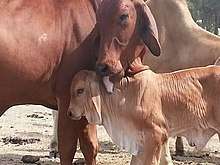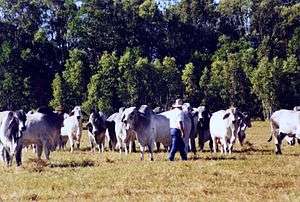Brahman cattle
The Brahman is an American breed of zebuine beef cattle. It was bred in the United States from 1885 from cattle originating in India, imported at various times from the United Kingdom, from India and from Brazil; these included Gir, Guzerá, Indu-Brasil and Ongole stock. The Brahman has a high tolerance of heat, sunlight and humidity, and good resistance to parasites. It has been exported to many countries, particularly in the tropics; in Australia it is the most numerous breed of cattle. It has been used in the creation of numerous taurine-indicine hybrids, some of which – such as the Brahmousin – are established as separate breeds.[2]:137[3][4]
_110307_REFON_2.jpg) Brahman bull in Avaré, Brazil | |
| Conservation status | FAO (2007): not at risk[1]:143 |
|---|---|
| Country of origin | United States |
| Distribution |
|
| Standard | American Brahman Breeders Association |
| Use | meat |
| |
Etymology
The Indian-origin Brahman cattle breed is named after the Brahmins (Hindu priests), who themselves are named after the Hindu deity Brahma. Many Hindu Brahmins are vegetarians and consider cows holy and bulls sacred, eating neither.[5]
Breeding and uses
.jpg)
The American Brahman was first bred in the early 1900s as a cross of four different Indian cattle breeds: Gujarat, Ongole, Gir and Krishna Valley.[6] The original American Brahman cattle originated from a nucleus of approximately 266 bulls and 22 females of several Bos indicus (cattle of India) varieties imported into the United States between 1854 and 1926.
The Brahman is used for the meat industry. It has been crossbred extensively with Bos taurus taurus (European) beef breeds of cattle. It has been used to develop numerous other U.S. beef breeds including Brangus, Beefmaster, Simbrah and Santa Gertrudis.
The breed is also used as a riding steer, and it is favoured for its docility, size, and intelligence.
Brahman cattle are known for their extreme tolerance to heat and are widespread in tropical regions. They are resistant to insects due to their thick skin. Brahman cattle live longer than many other breeds, often producing calves at ages 15 and older.[6]
In Oman and Fujairah, Brahman bulls are used in the traditional sport of bull-butting. It involves two of these bulls engaging in a ferocious round of headbutts. The first one to collapse or concede its ground is deemed the loser. Brahman bulls being readied for this sport are kept on a special diet of milk and honey for gaining superior strength.[7]
United States
The American Brahman Breeders Association was formed in 1924 as the official herd registry to track and verify cattle bloodlines. This organization is now headquartered in Houston. The name "Brahman" was created by the American Brahman Breeder's Association first secretary, Mr. J. W. Sartwelle.[8]
Australia

The Brahman Breed has made a major impact on the Australian beef cattle market, especially in the northern parts of Australia. Since the introduction of the breed to Australia, over 50% of Australia's cattle population are either Brahman or Brahman cross cattle. The breed does well not only in hot temperatures but also in the colder climate. There are breeders of the Brahman breed in Victoria right through to North Queensland. It is a common misconception that the breed will not "do well" in cold climates; a number of breeders in Central Victoria run these animals where temperatures can be extremely cold (sub-zero) and even can experience snow falls in the surrounding districts.
In Australia, the Brahman Breeders Association of Australia is the body in which members register their cattle and can become members if they wish to have registered cattle. However, there are a number of people which breed "commercial" cattle in which they are not registered breeders, these breeders supply cattle for the beef market commonly use stud bulls to improve the quality of their stock.
Gallery
- Red Brahman cows
 Brahman bulls in a paddock, Tipperary Station, Northern Territory, Australia
Brahman bulls in a paddock, Tipperary Station, Northern Territory, Australia
References
- Barbara Rischkowsky, D. Pilling (eds.) (2007). List of breeds documented in the Global Databank for Animal Genetic Resources, annex to The State of the World's Animal Genetic Resources for Food and Agriculture. Rome: Food and Agriculture Organization of the United Nations. ISBN 9789251057629. Accessed January 2017.
- Valerie Porter, Lawrence Alderson, Stephen J.G. Hall, D. Phillip Sponenberg (2016). Mason's World Encyclopedia of Livestock Breeds and Breeding (sixth edition). Wallingford: CABI. ISBN 9781780647944.
- Marleen Felius (1995). Cattle Breeds: An Encyclopedia. Doetinchem, Netherlands: Misset. ISBN 9789054390176.
- Hilton Marshall Briggs, Dinus M. Briggs (1980). Modern Breeds of Livestock. London; New York: Macmillan. Also cited in: Breeds of Livestock - Brahman Cattle. Department of Animal and Food Sciences, Oklahoma State University. Accessed April 2019.
- Rachel Cutrer (4 March 2014). That is a Brahman ... Or is it?. Brahman Journal. Archived 1 April 2015.
- Breeds of Livestock - Brahman Cattle. Department of Animal and Food Sciences, Oklahoma State University. Accessed April 2019.
- "Bullfighting à la Batinah". Rough Guides.
- John B. Friend (1978). Cattle of the World. Poole: Blandford Press. ISBN 9780713708561.
External links
| Wikimedia Commons has media related to Brahman (cattle). |
- American Brahman Breeders Association
- Australian Brahman Breeders Association
- Brahman Cattle - Cattle.com
- Brahman Cattle Video - A Video on the American Brahman
- "Weird Cow Breeds: The American Brahman - The cow with the big long ears". August 27, 2017.